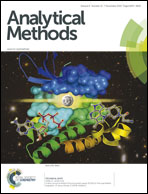On-line micelle to solvent stacking in capillary electrophoresis for the preconcentration of three antihistamines from human plasma
Abstract
A new on-line concentration method of micelle to solvent stacking in capillary electrophoresis was developed for the determination of three antihistamine drugs (chlorpheniramine, diphenhydramine and promethazine) in human plasma. Palmatine was used as an internal standard. The main parameters that affect the ability of the developed method to detect and separate the three drugs were investigated and optimized. Under the optimized conditions, the sensitivity enhancement factors obtained by this method for diphenhydramine, chlorpheniramine and promethazine were 63, 43 and 111, respectively. The method showed good linearity in the range of 0.6–60.0 μg mL−1 for the three antihistamines with the correlation coefficients varying from 0.9971 to 0.9996. The limits of detection (S/N = 3) were 0.1–0.2 μg mL−1. The relative standard deviations for intra-day (n = 8) and inter-day (n = 5) analysis were found to be less than 9.1%. The recoveries of the method for the analytes were in the range from 89.7% to 108.0%. The method is feasible for fast screening of the antihistamine drugs in plasma.


 Please wait while we load your content...
Please wait while we load your content...